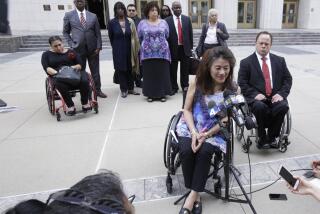FAA to Accommodate Wheelchair Users : Disabled Pilot Wins Access Battle
- Share via
A paraplegic pilot has won his legal battle to make buildings at Van Nuys Airport accessible to the handicapped.
In a settlement ending a lawsuit filed by Jeffrey Minnebraker, the Federal Aviation Administration has pledged to remodel its office building at the airport to make it accessible to wheelchairs or to move into a new facility designed to meet the needs of the handicapped.
The FAA also agreed to pay Minnebraker $5,000 to end the lawsuit and $45,000 to cover his legal expenses. The settlement was approved Tuesday by U.S. District Judge Terry J. Hatter Jr.
The agreement comes 10 months after Minnebraker reached a similar settlement with the city of Los Angeles, which owns the airport and was named as a defendant in the suit.
According to that agreement, unanimously approved Oct. 30 by the Los Angeles City Council, the city pledged to require ramps, wider doors, elevators and special restrooms in 29 privately owned buildings. The city also agreed to pay Minnebraker $83,000, a portion of which was for legal expenses. Neither the city nor the FAA could estimate the cost of the improvements.
The agreements stemmed from a $2-million lawsuit filed in 1985 by Minnebraker, who owns Amphibians West, a company that houses and maintains corporate jets and customizes seaplanes at Van Nuys Airport. Minnebraker, 35, learned to fly after his legs were paralyzed 14 years ago in an automobile accident near his home in Santa Monica.
The lawsuit alleged that Los Angeles and FAA officials had failed to meet regulations requiring most buildings at the airport to provide ramps, restrooms and other facilities for the handicapped, said Minnebraker’s attorney, Nora Quinn, of the Western Law Center for the Handicapped at Loyola Law School.
Modifications are not required for some older buildings at the airport because they were built before the regulations for handicapped access were adopted. If they undergo major remodeling, however, they will have to meet the access requirements, Quinn said.
She said city employees have begun inspecting the 29 privately owned buildings and will cite businesses that do not provide appropriate access. Owners of buildings violating city codes are responsible for paying for ramps, special restrooms or other improvements, Quinn said.
Minnebraker said he did not file his lawsuit to win special treatment at the airport. His aim, he said, was to bring buildings up to code.
Minnebraker said he found it difficult to conduct business at the airport because he could not enter certain buildings. On one occasion, he said, he had to crawl up steps and drag his wheelchair behind him to attend a meeting with FAA officials at the agency’s airport headquarters.
Quinn said Minnebraker had complained to federal officials about access problems before filing the suit. According to the settlement, the FAA has until February, 1990, to remodel its offices or to move to another building, Quinn said.
More to Read
Sign up for Essential California
The most important California stories and recommendations in your inbox every morning.
You may occasionally receive promotional content from the Los Angeles Times.













